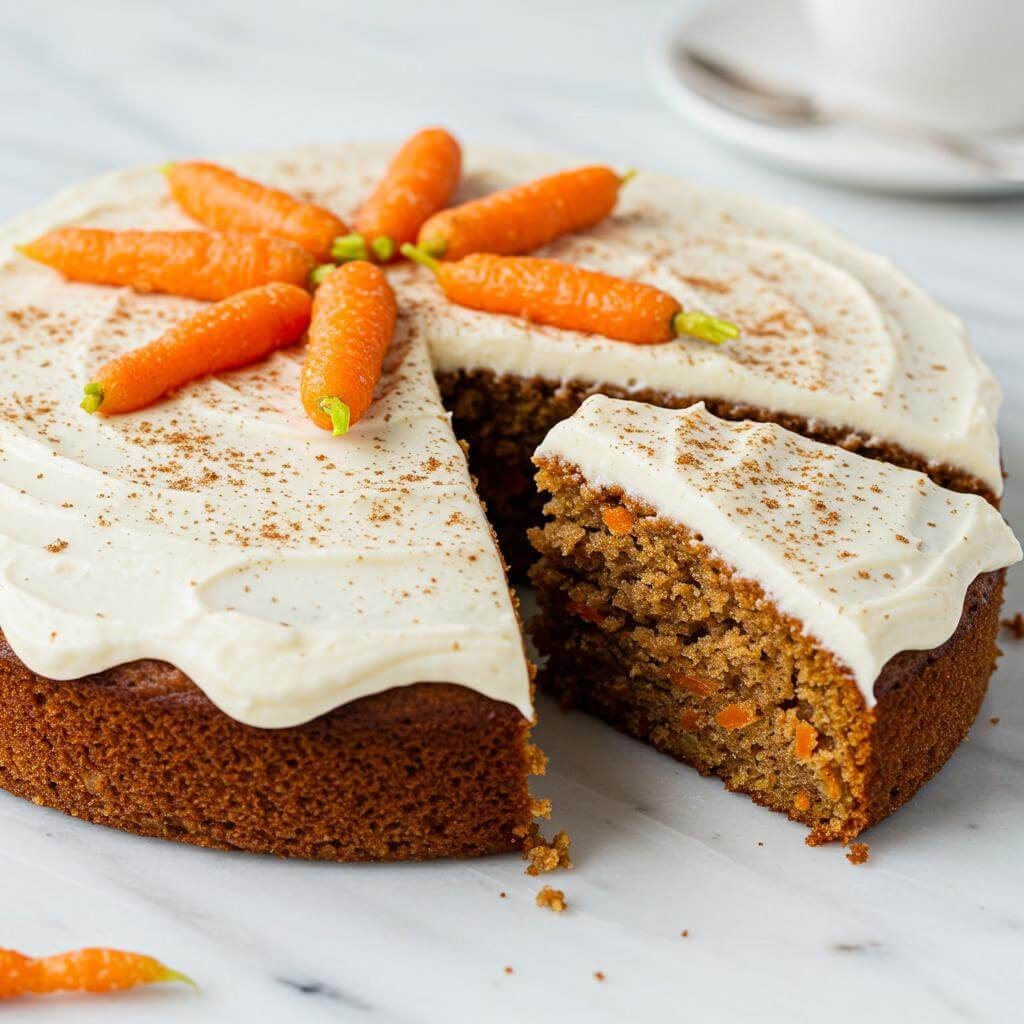
Discover Pure Joy: The Easiest Gluten Free Carrot Cake You’ll Ever Bake!
Oh, carrot cake! That beautifully spiced, wonderfully moist treat is a classic for a reason. But if you’re navigating the gluten-free world, you might have encountered your fair share of underwhelming versions – perhaps a bit too dry, a tad too crumbly, or just… lacking that special something. Well, gluten-free foodies, prepare to rejoice! We’re about to introduce you to a gluten free carrot cake recipe that isn’t just good for gluten-free; it’s simply spectacular, period. This isn’t just any recipe; it’s quite possibly the easiest, most rewarding gluten free carrot cake you’ll ever welcome into your kitchen, promising a truly delightful experience from mixing bowl to the very last bite.
Imagine a cake so soft, tender, and packed with flavor that it becomes your new go-to for every occasion, or even just a Tuesday afternoon pick-me-up. This gluten free carrot cake is exactly that. It’s a breeze to whip up, practically a one-bowl wonder, making it perfect for seasoned bakers and gluten-free beginners alike. We’re talking minimal fuss for maximum deliciousness – a truly fail-proof method to achieve cake perfection. And the crowning glory? A luscious, light, and fluffy cream cheese frosting that’s a delightful departure from overly sweet, heavy alternatives. It’s the kind of frosting that perfectly complements the warm spices and sweet carrots without overpowering them, creating a harmonious bite every single time. If you’re also a fan of easy, comforting bakes, you might fall in love with our Gluten-Free Banana Bread too!
What makes this particular gluten free carrot cake recipe so special? It’s all in the thoughtful combination of ingredients and techniques. Being an oil-based cake means it stays wonderfully moist and soft, even straight from the fridge (which is where you’ll want to keep it, thanks to that dreamy frosting!). We also insist on coarsely grated carrots; this is key because finely grated ones can release too much moisture, potentially leading to a denser cake. Here, the carrots provide a delightful texture and pockets of sweetness. And don’t worry about a crumbly result – the right gluten-free flour blend, sometimes with a touch of xanthan gum (if your blend doesn’t already include it), ensures a perfect structure. This recipe demystifies gluten-free baking, proving that you don’t need complicated steps to achieve a truly amazing cake. It’s a wonderful addition to a diverse and satisfying gluten-free diet, ensuring you never feel like you’re missing out on classic comforts. For another simple yet impressive treat, why not try our delightful Gluten-Free Muffins?
Get ready to fill your home with the incredible aroma of baking spices, and prepare to share a gluten free carrot cake that will have everyone, gluten-free or not, asking for seconds. This recipe is more than just a set of instructions; it’s an invitation to create joyful, delicious memories, one easy slice at a time.
Why This Gluten Free Carrot Cake Recipe Works Like Magic!
Get ready to discover the secrets behind this truly exceptional gluten free carrot cake! Baking without gluten can sometimes feel like navigating a minefield, but this recipe completely defies those challenges, delivering a cake that’s not just ‘good for gluten-free,’ but simply *delicious*. Let’s dive into why this particular gluten free carrot cake stands head and shoulders above the rest.
The Foundation: A Perfectly Balanced Gluten Free Flour Blend and the Power of Xanthan Gum
At the heart of any great gluten-free bake is a well-formulated flour blend. This recipe calls for a plain gluten-free flour blend and specifically mentions the *optional but often necessary* addition of xanthan gum. Why is this so important? Gluten, the protein network found in wheat, provides structure and elasticity. Without it, baked goods can be crumbly and dry. Xanthan gum steps in as a brilliant binder. It’s a polysaccharide that, when hydrated, creates a viscous, gel-like substance that helps to mimic the binding properties of gluten. It holds air bubbles created by leavening agents, preventing the cake from collapsing and ensuring a tender, cohesive crumb rather than a pile of crumbs. The careful balance between the flour blend itself and the specific amount of added xanthan gum (or relying on it if present in the blend) is key to achieving that desirable soft, moist, and non-crumbly texture in this gluten free carrot cake.
Moisture Mastery: The Role of Oil and Brown Sugar
One common pitfall in gluten-free baking is dryness. This gluten free carrot cake recipe actively combats this by relying on oil as the primary fat source rather than butter. Unlike butter, which is solid at room temperature, oil remains liquid. This means it coats the gluten-free flour particles more effectively, inhibiting them from drying out and contributing to a wonderfully moist crumb that stays soft long after baking. Furthermore, the use of light brown soft sugar doesn’t just add a rich, caramel-like flavour; its moisture content and slight acidity (thanks to the molasses) help keep the cake tender. The interplay of the wet ingredients – oil, eggs, vanilla, and brown sugar – creates a luscious base that carries the flavour and moisture throughout the finished gluten free carrot cake. The fact that this oil-based cake stays soft even when chilled (essential for storing the cream cheese frosting!) is a huge bonus!
Leavening for Lift: Baking Soda, Baking Powder, and Acid
Achieving adequate rise and a light texture without the elastic network of gluten requires a robust leavening system. This recipe smartly employs both baking powder and baking soda. Baking powder is a complete leavener, containing both an acid and a base that react when wet and heated. Baking soda, however, requires an external acid to activate fully. In this gluten free carrot cake, the light brown sugar (with its inherent acidity from molasses) provides the perfect counterpoint to the baking soda. This dual-action leavening ensures plenty of carbon dioxide bubbles are produced, creating lift and contributing to the cake’s fluffy texture, compensating for the lack of gluten structure.
Texture Contributions: Coarse Carrots and Walnuts
While they provide classic carrot cake flavour, the preparation of the carrots themselves plays a vital textural role. Specifying *coarsely* grated carrots prevents them from releasing too much moisture too quickly during baking, which can make a gluten-free cake gummy or dense. Coarsely grated carrots retain some structure, adding pleasant little pockets of tender sweetness throughout the cake. The addition of roughly chopped walnuts (or pecans) offers a delightful textural contrast – a satisfying crunch against the soft cake crumb. These additions aren’t just flavour enhancers; they are integral to the overall mouthfeel of this fantastic gluten free carrot cake.
The Frosting That Elevates Everything: Heavy Cream Instead of Butter
While not strictly part of the gluten-free structure, the frosting is a crucial element of any carrot cake experience! This recipe’s innovative cream cheese frosting uses heavy or double cream instead of the traditional butter/cream cheese blend. This simple swap is pure genius! It results in a frosting that is significantly lighter, less dense, and wonderfully fluffy. Because heavy cream whips up and stabilizes so beautifully, the frosting requires less powdered sugar than traditional versions to achieve a spreadable consistency. This translates to a less intensely sweet frosting that lets the tangy cream cheese flavour shine, perfectly balancing the spiced sweetness of the gluten free carrot cake itself. It pipes or spreads beautifully and holds its shape, making decorating a breeze.
Simplicity Equals Success: The One-Bowl Method
The “one-bowl” nature of this recipe is not just about easy cleanup; it’s also beneficial for gluten-free baking success. Minimizing mixing after adding the dry ingredients helps prevent overdevelopment of the batter, which can happen even without gluten (leading to a tougher texture depending on the starches in the blend). The simple whisking process ensures everything is just combined, leading to a more tender result.
In summary, this easy gluten free carrot cake recipe works by expertly balancing the moisture-retaining qualities of oil and brown sugar with the binding power of xanthan gum and the lifting action of a dual leavening system. Thoughtful textural additions like coarse carrots and the brilliant, lighter cream cheese frosting create a harmonious and utterly delicious bake that proves gluten-free absolutely doesn’t mean flavour-free or texture-compromised. This recipe is a winner, delivering a moist, tender, and flavorful gluten free carrot cake every single time! Happy baking!
Transform Your Mornings with 33 FREE Gluten-Free Breakfasts!
Unlock delicious, easy-to-make recipes that will make you excited to start every single day. No more boring breakfasts, just pure flavor and joy!

Get Your FREE Breakfast Ebook Now!
(No credit card required. Instant download.)
Ingredients
Crafting the perfect moist and flavorful gluten free carrot cake starts with selecting the right ingredients. Below is the list of everything you’ll need, with notes on some key components for gluten-free baking success.
- For the Gluten Free Carrot Cake:
- 225 g (1 cup + 2 tbsp) light brown soft sugar
- 120 g (½ cup + 1 tbsp) sunflower or vegetable oil
- 3 US large/UK medium eggs, room temperature
- ½ tsp vanilla bean paste (or 1 tsp vanilla extract)
- 200 g (1⅔ cups) plain gluten free flour blend (Using a good quality gluten free flour blend designed for cakes is essential for texture. Note that the volume measurement for this can vary, using a kitchen scale for grams is highly recommended for accuracy.)
- ¾ tsp baking powder
- ¾ tsp baking soda
- ½ tsp xanthan gum (Xanthan gum is a vital binder in gluten-free baking, mimicking the structure provided by gluten. It helps prevent your cake from being crumbly. Check your flour blend – if it already contains xanthan gum or other binders like guar gum or psyllium husk, you can omit this extra amount. You can find xanthan gum here.)
- ¼ tsp salt
- 1½ tsp ground cinnamon
- ½ tsp ground ginger
- ¼ tsp ground nutmeg
- 225 g (about 2¼ cups) peeled and coarsely grated carrots (about 3-4 medium carrots) (Weighing is best for consistency as cup measurements can vary based on how packed the carrots are.)
- 90 g (about ¾ cup) walnuts, roughly chopped
- For the Cream Cheese Frosting:
- 170 g (¾ cup) cream cheese, cold from the fridge
- 175 g (¾ cup) heavy/double cream, cold from the fridge
- 80 g (⅔ cup) powdered/icing sugar, sifted (Adjust to your desired sweetness level.)
- ½ tsp vanilla bean paste (or 1 tsp vanilla extract)
- walnuts, roughly chopped, for decoration
Ingredient Insight: The combination of baking soda and light brown sugar is clever! Baking soda needs an acidic ingredient to activate and produce gases, helping the cake rise. The molasses in light brown sugar provides this acidity, ensuring your gluten free carrot cake is beautifully light and fluffy.
Nutritional Information
While precise nutritional counts vary based on ingredients used and serving size, this gluten free carrot cake offers some wonderful benefits within a delicious treat. Being entirely gluten-free, it’s perfect for those with Celiac disease or gluten sensitivity, allowing everyone to enjoy a classic dessert.
The generous amount of carrots adds natural sweetness, moisture, and beneficial fiber, as well as Vitamin A. The inclusion of walnuts contributes healthy fats (omega-3s), protein, and additional fiber, adding to the nutritional profile and providing a lovely textural contrast. The frosting, using heavy cream instead of relying heavily on butter and powdered sugar, offers a lighter mouthfeel and can be less sweet than many traditional cream cheese frostings, allowing the flavors of the gluten free carrot cake to shine through.
Substitutions & Variations
One of the joys of baking is making a recipe your own! This easy gluten free carrot cake recipe is quite forgiving, and here are some ways you can adapt it to suit different dietary needs or flavor preferences, all while keeping it wonderfully gluten-free.
Substitutions
- Gluten-Free Flour Blend: We recommend using a blend specifically formulated for cakes. If your blend already contains xanthan gum, make sure to omit the extra ½ tsp listed in the recipe to avoid a gummy texture. Different blends can absorb liquid differently, so minor adjustments to bake time might sometimes be needed depending on the blend used. Experimentation with a few different gluten free flour blends might be needed to find your favorite!
- Oil: While sunflower or vegetable oil is specified, you can use other neutral-flavored liquid oils like canola oil or light olive oil. Avoid strong-flavored oils like extra virgin olive oil unless you want that specific taste. Melted coconut oil (liquid state) could also work but will impart a slight coconut flavor.
- Eggs: Substituting eggs in baking can be tricky, especially in oil-based cakes where they contribute structure and moisture. While not explicitly tested for this version, common egg substitutes like commercial egg replacers, unsweetened applesauce (use about ¼ cup per egg, may affect texture), or flax eggs (1 tbsp flax meal + 3 tbsp water per egg, let sit to gel) *might* work, but the texture could change. This recipe hasn’t been developed as an egg-free gluten free carrot cake, so results with substitutes are not guaranteed to be identical.
- Dairy-Free Frosting: To make the frosting dairy-free, substitute the cream cheese with a dairy-free cream cheese alternative and the heavy cream with a dairy-free heavy cream alternative (like coconut cream from a can, chilled and scooped, or a commercial plant-based whipping cream). Ensure both are cold and whisk until thickened. The stability might vary depending on the product used.
- Nuts: Walnuts add a wonderful crunch and flavor, but if you have a nut allergy or simply prefer not to use them, you can omit them entirely or substitute with other mix-ins like raisins, sultanas, or dried cranberries. Pecans are a popular alternative to walnuts in gluten free carrot cake.
Variations
- Spice it Up: While cinnamon, ginger, and nutmeg are classics, consider adding a pinch of ground cardamom or allspice for an extra layer of warmth and complexity to your gluten free carrot cake.
- Add More Mix-ins: Besides or instead of walnuts, fold in a handful of raisins, sultanas, dried cranberries, or even some shredded unsweetened coconut. A bit of fresh orange zest folded into the batter or frosting can also brighten the flavors beautifully.
- Different Frosting: If making the cake dairy-free, you could opt for a simple glaze made from powdered sugar and a little plant-based milk or orange juice instead of a full cream cheese frosting. A vanilla buttercream (using dairy-free butter/margarine if needed) is another option, though it will be richer and sweeter than the cream cheese version.
Storage Tips
Due to the cream cheese frosting, it’s essential to store your delicious gluten free carrot cake properly. Keep the cake in a closed container in the fridge for 3-4 days to maintain freshness and food safety. While oil-based cakes often stay soft even when cold (unlike butter-based ones), letting a slice sit at room temperature for a few minutes before serving can enhance its texture and flavor.
Essential Equipment for This Recipe
To prepare this delicious recipe, you’ll need the following kitchen tools:
- Mixing Bowls – A set of good mixing bowls is crucial for combining your ingredients smoothly.
Find Mixing Bowls on Amazon - Measuring Cups and Spoons – Precision is key in baking! Ensure accurate measurements with these.
Find Measuring Cups and Spoons on Amazon - Baking Sheets – Essential for baking cookies, roasting vegetables, and more.
Find Baking Sheets on Amazon - Whisks – Perfect for whipping cream, eggs, or blending dry ingredients.
Find Whisks on Amazon - Spatulas – Ideal for folding, scraping, and mixing ingredients thoroughly.
Find Spatulas on Amazon - Food Processors – For quick chopping, shredding, or pureeing.
Find Food Processors on Amazon - Saucepans – For heating sauces, melting butter, or cooking small batches.
Find Saucepans on Amazon - Chef’s Knives – A versatile knife for almost any cutting task.
Find Chef’s Knives on Amazon - Cutting Boards – A safe and clean surface for all your chopping needs.
Find Cutting Boards on Amazon
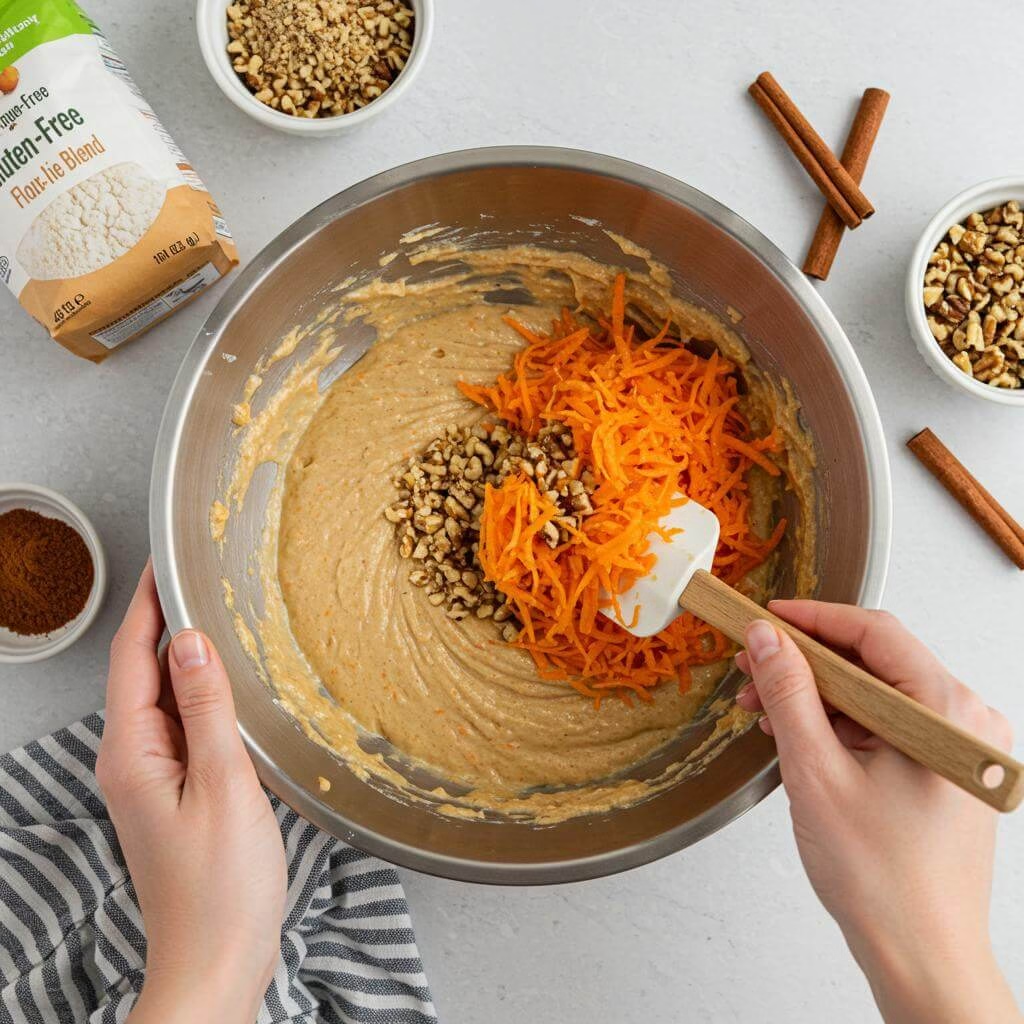
- Prepare for Baking: Begin by adjusting your oven rack to the middle position. Preheat your oven to 350ºF (180ºC). This moderate temperature ensures the cake bakes evenly without burning the edges before the center is cooked through. Next, take your 9-inch (23cm) square baking tin and line it completely with parchment or baking paper. A handy tip here is to leave a little extra paper hanging over the sides of the tin. This overhang acts as handles, making it much easier to lift the finished gluten free carrot cake out once it’s baked and cooled slightly.
- Combine Wet Ingredients: In a large mixing bowl, measure out your wet ingredients: the light brown soft sugar, sunflower or vegetable oil, room-temperature eggs, and vanilla bean paste or extract. Using a whisk, combine these ingredients thoroughly until you have a smooth mixture. The sugar should start to dissolve, and everything should be well incorporated.
- Sift in Dry Ingredients: Now it’s time to add the dry components that will give your gluten free carrot cake its structure and flavor. Directly over the wet ingredients in the bowl, sift in your plain gluten free flour blend, baking powder, baking soda, xanthan gum (if your flour blend doesn’t already contain it), salt, ground cinnamon, ground ginger, and ground nutmeg. Sifting helps to aerate the dry ingredients and prevents clumps in the final batter. Using a kitchen scale to measure the flour blend is recommended for the most accurate results in gluten-free baking.
- Mix the Batter: Using your whisk, gently mix the wet and dry ingredients together. Continue whisking until you have a smooth, uniform batter with no pockets of dry flour visible. Be careful not to overmix the batter; just mix until it’s smooth. Overmixing gluten-free batters with binders like xanthan gum can sometimes result in a tougher or gummier texture.
- Fold in Carrots and Walnuts: Add the star ingredients to the batter: the coarsely grated carrots and the roughly chopped walnuts (if using). Ensure you use *coarsely* grated carrots, as finely grated ones can release too much moisture and make the cake dense. Use a rubber spatula or wooden spoon to gently fold these additions into the batter until they are evenly distributed throughout. Don’t overwork the batter at this stage.
- Transfer to Tin: Carefully pour or spoon the prepared gluten free carrot cake batter into the lined 9-inch (23cm) baking tin. Use your spatula to spread the batter evenly and smooth out the top. This helps ensure your cake bakes flat and evenly.
- Bake the Cake: Place the tin in your preheated oven. Bake for approximately 35 minutes. The exact baking time can vary depending on your oven, so keep an eye on it. You’ll know the cake is done when it’s well-risen, has a beautiful golden-brown color on top, and when you insert a toothpick or cake tester into the center, it comes out clean with no wet batter attached. If the top starts browning too quickly before the center is done, you can lightly cover the tin with a sheet of aluminum foil (shiny side up) to prevent further browning while the inside finishes baking.
- Cool the Cake: Once baked, remove the gluten free carrot cake from the oven and let it cool in the baking tin for about 10-15 minutes. This allows the cake to set slightly before you move it. Then, using the parchment paper overhang as handles, carefully lift the cake out of the tin and transfer it onto a wire cooling rack to cool down completely. It is absolutely crucial that the cake is cooled *completely* before you even think about adding the frosting. Warm cake will melt the cream cheese frosting, resulting in a messy disaster.
- Prepare for Frosting: While the cake cools, you can prepare the light and fluffy cream cheese frosting. You have a few options for mixing: a stand mixer fitted with the whisk attachment, a hand mixer with beaters, or a large balloon whisk for mixing by hand. Make sure your cream cheese is cold from the fridge. In a large bowl (or your stand mixer bowl), whisk the cold cream cheese until it is smooth and its texture is a bit looser. This initial whisking helps prevent lumps.
- Whip the Frosting: Add the cold heavy or double cream, the sifted powdered or icing sugar, and the vanilla bean paste or extract to the bowl with the cream cheese. Start whisking on a low speed to combine, then increase the speed. Whip the mixture until soft peaks form. The frosting should be thick enough to hold its shape when you swirl it with a spoon or spatula, but still light and fluffy. Be careful not to over-whip, as this can make the frosting too stiff. This recipe uses less sugar than many traditional frostings, resulting in a less sweet, wonderfully stable frosting for your gluten free carrot cake. You can adjust the amount of sugar to your personal taste.
- Frost and Serve: Once your gluten free carrot cake is completely cooled, spoon the prepared cream cheese frosting onto the top. Use a small offset spatula or the back of a spoon to spread the frosting all the way to the edges of the cake, creating beautiful swirls and swoops as you go. Sprinkle some extra chopped walnuts over the top for decoration if desired. Now your delicious gluten free carrot cake is ready to be sliced and enjoyed! Store any leftovers in a closed container in the fridge, where it will keep well for 3-4 days.
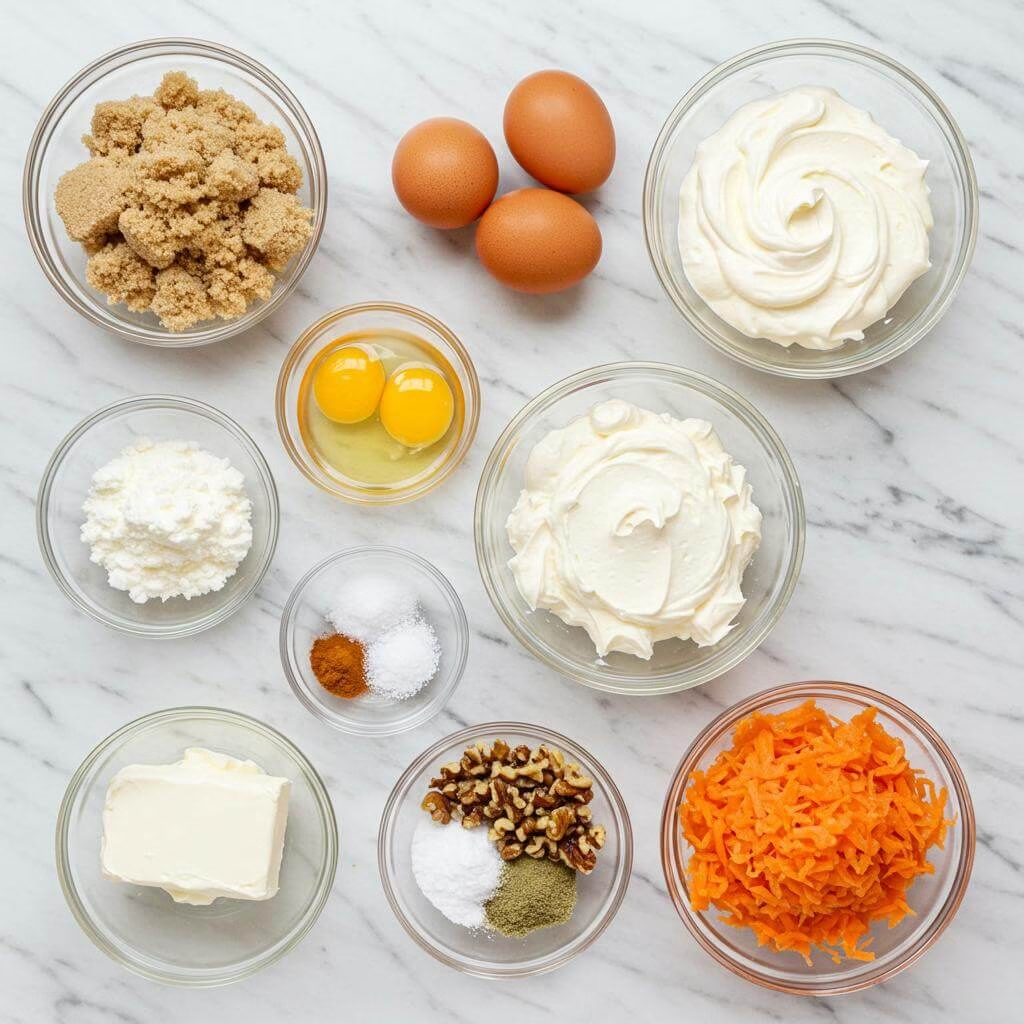
Tips for Perfect Gluten Free Carrot Cake
Ready to bake the most delicious gluten free carrot cake? Here are some expert tips to ensure yours turns out perfectly moist, tender, and utterly delightful, just like the recipe promises!
- Weigh Your Ingredients for Accuracy: Especially for gluten-free baking, precision is key! Gluten-free flours differ slightly in weight per volume compared to wheat flour, and even grated carrots can be packed differently into a measuring cup. Using a kitchen scale for the flour and grated carrots, as recommended in the recipe, guarantees you have the exact amounts needed for the perfect batter consistency. This is crucial for achieving the ideal texture in your gluten free carrot cake.
- Use Room Temperature Eggs: The recipe calls for room temperature eggs for a reason! Room temperature eggs emulsify better with the oil and sugar, creating a smoother, more uniform batter. This helps with the overall structure and rise of your gluten free carrot cake, leading to a lighter crumb.
- Sift the Dry Ingredients: Don’t skip the sifting step! Sifting your gluten free flour blend, leavening agents, spices, and xanthan gum (if adding) removes any lumps and aerates the mixture. This results in a lighter flour mixture that incorporates more easily into the wet ingredients, preventing dense spots and ensuring even distribution of flavour and leavening throughout your gluten free carrot cake batter.
- Whisk Just Until Combined: Once you’ve added the dry ingredients, whisk only until you have a smooth batter with no visible flour clumps. Over-mixing gluten-free batter can sometimes lead to a tougher or gummier texture because while there’s no gluten to develop, the starches and binders can still be negatively affected by excessive handling. Gentle whisking is all you need for this easy gluten free carrot cake.
- Coarsely Grate Those Carrots: As the recipe emphasizes, using coarsely grated carrots is vital for this gluten free carrot cake. Finely grated carrots can release too much moisture into the batter, potentially making the cake too wet and dense. Coarse shreds provide moisture without oversaturating and contribute wonderful texture to each bite.
- Check Your Gluten Free Flour Blend for Xanthan Gum: Many commercially available gluten-free flour blends already contain xanthan gum or other binders. If yours does, you can omit the extra ½ teaspoon listed in the recipe. Adding too much xanthan gum can result in a gummy or overly chewy texture, which we want to avoid in our perfect gluten free carrot cake.
- Don’t Rush the Cooling: It’s absolutely crucial to let your gluten free carrot cake cool completely on a wire rack before you even think about frosting it. Frosting a warm cake will cause the frosting to melt and slide right off, creating a gooey mess instead of a beautifully decorated treat. Patience is key here!
- Whip the Frosting to Soft Peaks: For the unique and delicious cream cheese frosting with heavy cream, whip it only until soft peaks just form. This gives you that lovely light and fluffy texture described. Over-whipping can make the frosting too stiff or even cause it to separate. You want it spreadable and smooth for your gluten free carrot cake.
Common Mistakes to Avoid in Gluten Free Carrot Cake
Even with a simple recipe, knowing what *not* to do can make all the difference in your gluten free carrot cake baking journey. Steer clear of these common pitfalls!
- Using the Wrong Size Grated Carrots: This is worth repeating! Using finely grated carrots instead of coarse ones can throw off the moisture balance of the cake, potentially making it heavy and wet rather than perfectly moist and tender. Always use coarse shreds for this gluten free carrot cake recipe.
- Frosting a Warm Cake: We touched on this above, but it’s a classic mistake. Applying frosting to a cake that isn’t completely cool will lead to a melted, unstable mess. Give your gluten free carrot cake ample time to cool on a wire rack before you start frosting.
- Guessing Ingredient Measurements: Relying on volume measurements (cups) instead of weight (grams) for gluten-free flour and carrots is a common trap. Due to variations in scooping and packing, cup measurements can be inaccurate, leading to an imbalance in the wet-to-dry ratio. Use a kitchen scale for the best results and a truly reliable gluten free carrot cake.
Frequently Asked Questions
Why is this gluten free carrot cake recipe described as “the easiest”?
This specific gluten free carrot cake recipe is designed to be incredibly simple and beginner-friendly! It’s essentially a “one-bowl” method. You mix all the wet ingredients in a large bowl, sift in the dry ones, whisk everything together until smooth, and then just fold in your carrots and walnuts. It minimizes steps and mess, making it really quick and, as the post mentions, 100% fail-proof for consistent, delicious results.
What makes this gluten free carrot cake so moist and tender?
Several things contribute to the wonderful texture of this gluten free carrot cake! Primarily, it’s an oil-based cake, which means it stays beautifully soft and moist, even straight from the fridge (unlike butter-based cakes which can firm up when chilled). Using coarsely grated carrots is also key; they release moisture during baking without making the cake too dense, while still providing lovely pockets of texture. The balance of leavening agents (baking powder and baking soda) and the use of xanthan gum (if your flour blend doesn’t already have it) also ensure a light, tender crumb that isn’t crumbly.
Do I really need xanthan gum for this gluten free carrot cake?
Xanthan gum acts as a binder in gluten-free baking, similar to what gluten does in traditional recipes – it helps provide structure and prevents the cake from becoming too crumbly. This recipe includes ½ tsp of xanthan gum. However, many commercial gluten free flour blends already contain xanthan gum or other binders like guar gum. If your specific gluten free flour blend lists xanthan gum (or other binders) in its ingredients, you should omit the extra ½ tsp to avoid a gummy texture. Always check your flour blend’s label!
Can I substitute the walnuts or add other things to this gluten free carrot cake?
Absolutely! The walnuts add a lovely crunch, but they are optional. If you have a nut allergy or prefer not to use them, you can omit them entirely. Pecans are also a popular and delicious alternative to walnuts in gluten free carrot cake. Additionally, feel free to fold in other mix-ins like raisins, sultanas, dried cranberries, or even some shredded unsweetened coconut along with or instead of the nuts for variations on this classic.
Tell me more about the cream cheese frosting – why is it different?
This cream cheese frosting recipe uses heavy or double cream instead of butter, which is common in many traditional recipes. This simple swap results in a frosting that is significantly lighter, fluffier, and less dense than butter-based versions. A great benefit is that it requires less powdered sugar for stability, making it less sweet than many other recipes. It’s also very easy to whip up and holds its shape beautifully on the cake, letting the delicious flavor of the gluten free carrot cake shine through.
How should I store the finished gluten free carrot cake?
Because the cake is topped with cream cheese frosting, it needs to be stored in the refrigerator. Keep the gluten free carrot cake in a closed, airtight container in the fridge. It will stay fresh and delicious for 3-4 days. Since it’s an oil-based cake, it should remain soft even when chilled, but letting a slice sit at room temperature for a few minutes before serving can sometimes enhance its texture and flavor further.

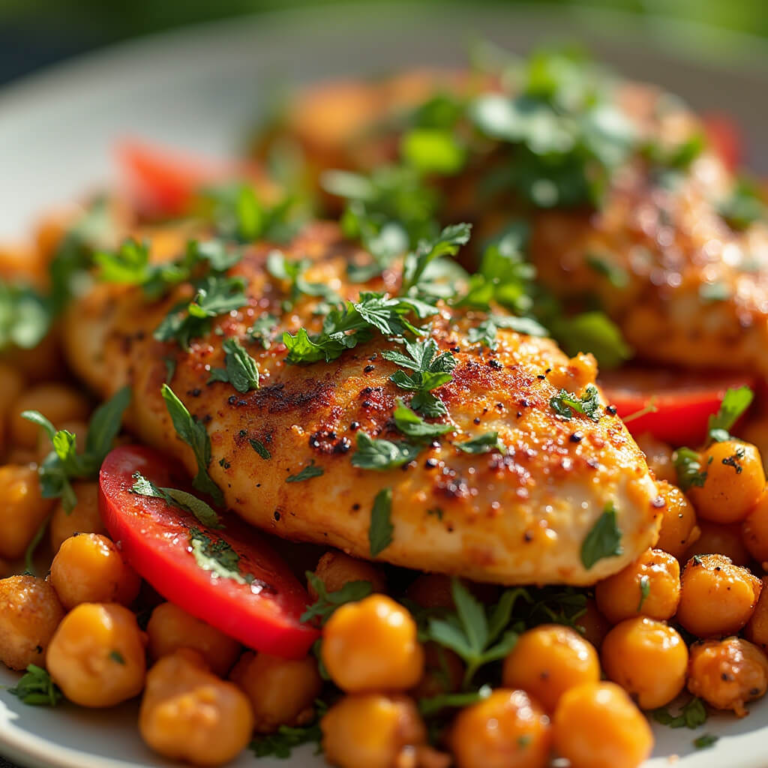

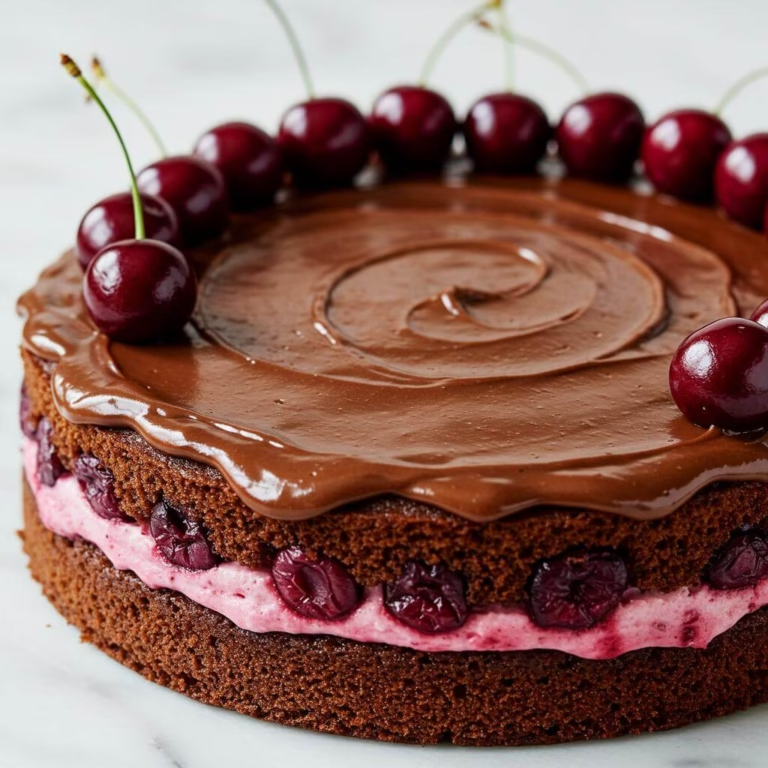
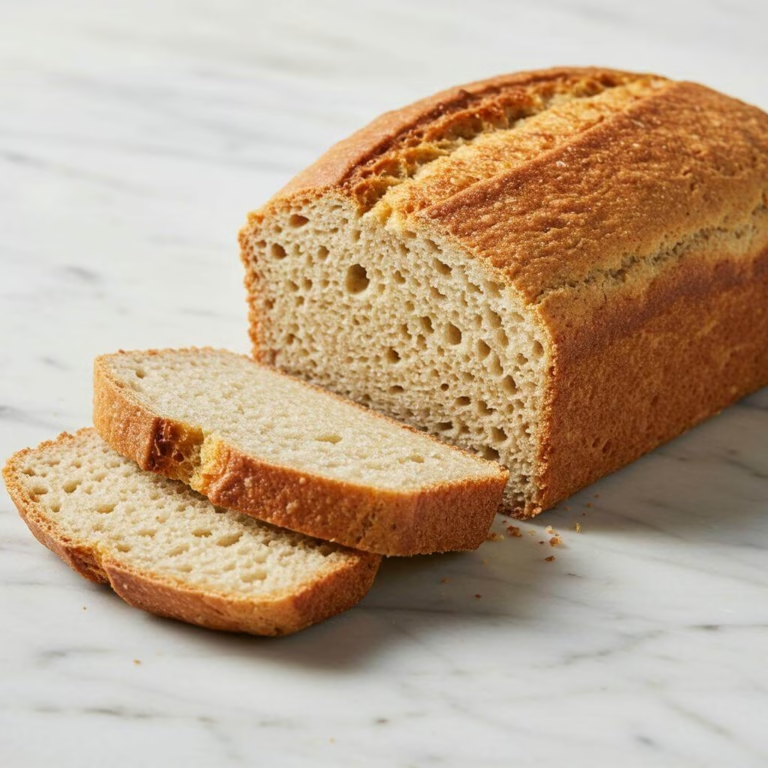
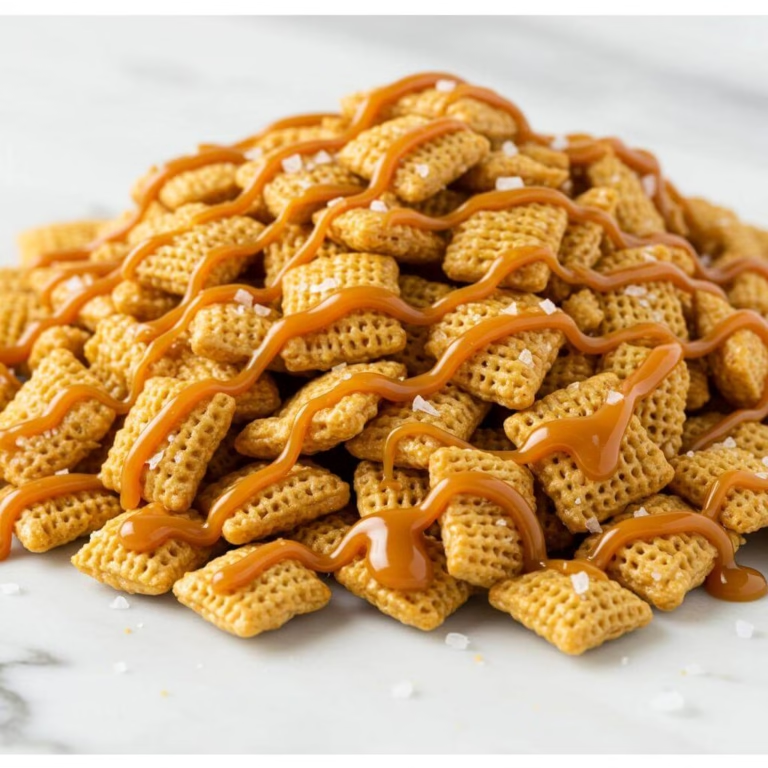

2 Comments